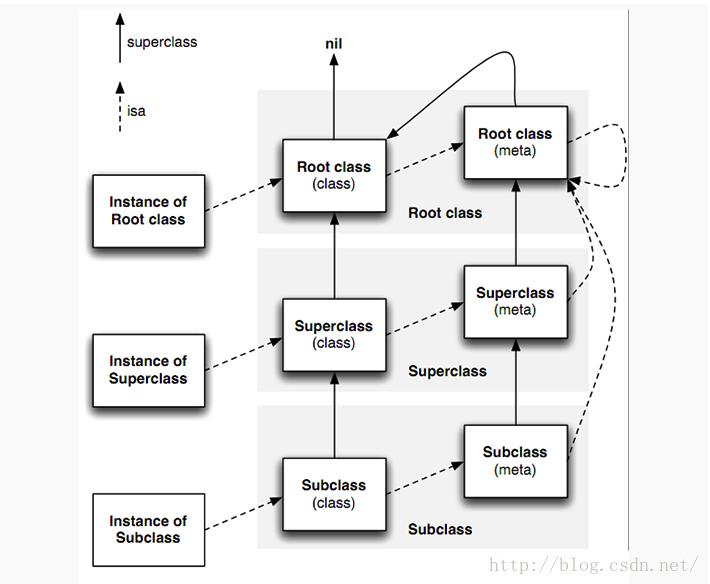runtime 详解
Posted liupinghui
tags:
篇首语:本文由小常识网(cha138.com)小编为大家整理,主要介绍了runtime 详解相关的知识,希望对你有一定的参考价值。
rumtime基础知识
Objective-C提供了编译运行时,只要有可能,它都可以动态地运行,这意味着不仅需要编译器,还需要运行时系统执行编译的代码,运行时系统充当Objective-C语言的操作系统,有了它才能运行。
运行时系统所提供功能是非常强大的,在实际开发中是经常使用到的。比如,苹果不允许我们给Category追加扩展属性,是因为它不会自动生成成员变量,那么我们通过运行时就可以很好的解决这个问题。另外,常见的模型转字典或者字典转模型,对象归档等。
于runtime交互
Objective-C程序有三种方式与runtime系统交互:
1.通过Objective-C原代码,编译器党编译包含Objective-C类和方法的代码时,编译器会创建实现语言动态特性的数据结构和函数调用。
2.通过foundation库中定义的NSObject提供的方法,NSObject提供了一些动态监测方法
3.直接通过调用runtime方法,直接调用#import <objc/runtime.h> 和#import <objc/objc.h>头文件里的函数
消息(Message)
typedef struct objc_class *Class;
struct objc_class {
Class isa; // 指向metaclass
Class super_class ; // 指向其父类
const char *name ; // 类名
long version ; // 类的版本信息,初始化默认为0,可以通过runtime函数class_setVersion和class_getVersion进行修改、读取
long info; // 一些标识信息,如CLS_CLASS (0x1L) 表示该类为普通 class ,其中包含对象方法和成员变量;CLS_META (0x2L) 表示该类为 metaclass,其中包含类方法;
long instance_size ; // 该类的实例变量大小(包括从父类继承下来的实例变量);
struct objc_ivar_list *ivars; // 用于存储每个成员变量的地址
struct objc_method_list **methodLists ; // 与 info 的一些标志位有关,如CLS_CLASS (0x1L),则存储对象方法,如CLS_META (0x2L),则存储类方法;
struct objc_cache *cache; // 指向最近使用的方法的指针,用于提升效率;
struct objc_protocol_list *protocols; // 存储该类遵守的协议
}我们可以看到,对于一个Class类中,存在很多东西,下面我来一一解释下:
Class isa:指向metaclass,也就是静态的Class。一般一个Obj对象中的isa会指向普通的Class,这个Class中存储普通的成员变量和对象方法(-开头的方法),普通的Class中的isa指针指向静态的Class,静态的Class中存储static类型的成员变量和类方法(+开头的方法)
Class super_class指向父类,如果这个类是根类,则为NULL。
下面一张图片很好的描述了类和对象的继承关系:

runtime关联属性
在开发中经常需要给已有的类扩展添加方法和属性,但是Objective-C是不允许给已有类扩展属性的,因为类扩展是不会自动生成成员变量的,但是,苹果提供了runtime,我们可以通过runtime使用。
关联API介绍/**
* Sets an associated value for a given object using a given key and association policy.
*
* @param object The source object for the association.
* @param key The key for the association.
* @param value The value to associate with the key key for object. Pass nil to clear an existing association.
* @param policy The policy for the association. For possible values, see “Associative Object Behaviors.”
*
* @see objc_setAssociatedObject
* @see objc_removeAssociatedObjects
*/
OBJC_EXPORT void objc_setAssociatedObject(id object, const void *key, id value, objc_AssociationPolicy policy)
__OSX_AVAILABLE_STARTING(__MAC_10_6, __IPHONE_3_1);
/**
* Returns the value associated with a given object for a given key.
*
* @param object The source object for the association.
* @param key The key for the association.
*
* @return The value associated with the key \\e key for \\e object.
*
* @see objc_setAssociatedObject
*/
OBJC_EXPORT id objc_getAssociatedObject(id object, const void *key)
__OSX_AVAILABLE_STARTING(__MAC_10_6, __IPHONE_3_1);
/**
* Removes all associations for a given object.
*
* @param object An object that maintains associated objects.
*
* @note The main purpose of this function is to make it easy to return an object
* to a "pristine state”. You should not use this function for general removal of
* associations from objects, since it also removes associations that other clients
* may have added to the object. Typically you should use \\c objc_setAssociatedObject
* with a nil value to clear an association.
*
* @see objc_setAssociatedObject
* @see objc_getAssociatedObject
*/
OBJC_EXPORT void objc_removeAssociatedObjects(id object)
__OSX_AVAILABLE_STARTING(__MAC_10_6, __IPHONE_3_1);
/**
* Sets an associated value for a given object using a given key and association policy.
*
* @param object The source object for the association.
* @param key The key for the association.
* @param value The value to associate with the key key for object. Pass nil to clear an existing association.
* @param policy The policy for the association. For possible values, see “Associative Object Behaviors.”
*
* @see objc_setAssociatedObject
* @see objc_removeAssociatedObjects
*/
OBJC_EXPORT void objc_setAssociatedObject(id object, const void *key, id value, objc_AssociationPolicy policy)
__OSX_AVAILABLE_STARTING(__MAC_10_6, __IPHONE_3_1);
/**
* Returns the value associated with a given object for a given key.
*
* @param object The source object for the association.
* @param key The key for the association.
*
* @return The value associated with the key \\e key for \\e object.
*
* @see objc_setAssociatedObject
*/
OBJC_EXPORT id objc_getAssociatedObject(id object, const void *key)
__OSX_AVAILABLE_STARTING(__MAC_10_6, __IPHONE_3_1);
/**
* Removes all associations for a given object.
*
* @param object An object that maintains associated objects.
*
* @note The main purpose of this function is to make it easy to return an object
* to a "pristine state”. You should not use this function for general removal of
* associations from objects, since it also removes associations that other clients
* may have added to the object. Typically you should use \\c objc_setAssociatedObject
* with a nil value to clear an association.
*
* @see objc_setAssociatedObject
* @see objc_getAssociatedObject
*/
OBJC_EXPORT void objc_removeAssociatedObjects(id object)
__OSX_AVAILABLE_STARTING(__MAC_10_6, __IPHONE_3_1);
关联策略
/* Associative References */
/**
* Policies related to associative references.
* These are options to objc_setAssociatedObject()
*/
typedef OBJC_ENUM(uintptr_t, objc_AssociationPolicy) {
OBJC_ASSOCIATION_ASSIGN = 0, /**< Specifies a weak reference to the associated object. */
OBJC_ASSOCIATION_RETAIN_NONATOMIC = 1, /**< Specifies a strong reference to the associated object.
* The association is not made atomically. */
OBJC_ASSOCIATION_COPY_NONATOMIC = 3, /**< Specifies that the associated object is copied.
* The association is not made atomically. */
OBJC_ASSOCIATION_RETAIN = 01401, /**< Specifies a strong reference to the associated object.
* The association is made atomically. */
OBJC_ASSOCIATION_COPY = 01403 /**< Specifies that the associated object is copied.
* The association is made atomically. */
};
我们说明一下各个值的作用:
OBJC_ASSOCIATION_ASSIGN:表示弱引用关联,通常是基本数据类型,如int、float
OBJC_ASSOCIATION_RETAIN_NONATOMIC:表示强(strong)引用关联对象
OBJC_ASSOCIATION_COPY_NONATOMIC:表示关联对象copy
OBJC_ASSOCIATION_RETAIN:表示强(strong)引用关联对象,但不是线程安全的
OBJC_ASSOCIATION_COPY:表示关联对象copy,但不是线程安全的
runtime模型与字典互转
objc_property_t *properties = class_copyPropertyList
objc_property_t property = properties[i];
const void *propertyName = property_getName(property);
NSString *key = [NSString stringWithUTF8String:propertyName];runtime自动归档/解档
unsigned int outCount = 0;
Ivar *ivars = class_copyIvarList([self class], &outCount);
// 获取成员变量名
const void *name = ivar_getName(ivar);
NSString *ivarName = [NSString stringWithUTF8String:name];
// 去掉成员变量的下划线
ivarName = [ivarName substringFromIndex:1];Runtime Message Forwarding
其流程是这样的:
第一步:+ (BOOL)resolveInstanceMethod:(SEL)sel实现方法,指定是否动态添加方法。若返回NO,则进入下一步,若返回YES,则通过class_addMethod函数动态地添加方法,消息得到处理,此流程完毕。
第二步:在第一步返回的是NO时,就会进入- (id)forwardingTargetForSelector:(SEL)aSelector方法,这是运行时给我们的第二次机会,用于指定哪个对象响应这个selector。不能指定为self。若返回nil,表示没有响应者,则会进入第三步。若返回某个对象,则会调用该对象的方法。
第三步:若第二步返回的是nil,则我们首先要通过- (NSMethodSignature *)methodSignatureForSelector:(SEL)aSelector指定方法签名,若返回nil,则表示不处理。若返回方法签名,则会进入下一步。
第四步:当第三步返回方法方法签名后,就会调用- (void)forwardInvocation:(NSInvocation *)anInvocation方法,我们可以通过anInvocation对象做很多处理,比如修改实现方法,修改响应对象等
第五步:若没有实现- (void)forwardInvocation:(NSInvocation *)anInvocation方法,那么会进入- (void)doesNotRecognizeSelector:(SEL)aSelector方法。若我们没有实现这个方法,那么就会crash,然后提示打不到响应的方法。到此,动态解析的流程就结束了。runtime objc_msgSend
objc_msgSend:其它普通的消息都会通过该函数来发送
objc_msgSend_stret:消息中需要有数据结构作为返回值时,会通过该函数来发送消息并接收返回值
objc_msgSendSuper:与objc_msgSend函数类似,只是它把消息发送给父类实例
objc_msgSendSuper_stret:与objc_msgSend_stret函数类似,只是它把消息发送给父类实例并接收数组结构作为返回值创建并初始化NSObject
创建对象
NSObject *obj = (NSObject *(*)(id,SEL)objc_msgSend)((id)[NSObject class],@selector(alloc));
初始化对象
obj = (NSObject *(*)(id,SEL)objc_msgSend)((id)msg,@selector(init));runtime Method
Method类型
Method类型是一个objc_method结构体指针,而结构体objc_method有三个成员:
/// An opaque type that represents a method in a class definition.
typedef struct objc_method *Method;
struct objc_method {
SEL method_name; // 方法名称
char *method_typesE; // 参数和返回类型的描述字串
IMP method_imp; // 方法的具体的实现的指针
} Method所有方法
// 函数调用,但是不接收返回值类型为结构体
method_invoke
// 函数调用,但是接收返回值类型为结构体
method_invoke_stret
// 获取函数名
method_getName
// 获取函数实现IMP
method_getImplementation
// 获取函数type encoding
method_getTypeEncoding
// 复制返回值类型
method_copyReturnType
// 复制参数类型
method_copyArgumentType
// 获取返回值类型
method_getReturnType
// 获取参数个数
method_getNumberOfArguments
// 获取函数参数类型
method_getArgumentType
// 获取函数描述
method_getDescription
// 设置函数实现IMP
method_setImplementation
// 交换函数的实现IMP
method_exchangeImplementationsclass_copyMethodList 获取方法列表
Type Encoding
编码值 含意
c 代表char类型
i 代表int类型
s 代表short类型
l 代表long类型,在64位处理器上也是按照32位处理
q 代表long long类型
C 代表unsigned char类型
I 代表unsigned int类型
S 代表unsigned short类型
L 代表unsigned long类型
Q 代表unsigned long long类型
f 代表float类型
d 代表double类型
B 代表C++中的bool或者C99中的_Bool
v 代表void类型
* 代表char *类型
@ 代表对象类型
# 代表类对象 (Class)
: 代表方法selector (SEL)
[array type] 代表array
{name=type…} 代表结构体
(name=type…) 代表union
bnum A bit field of num bits
^type A pointer to type
? An unknown type (among other things, this code is used for function pointers)Runtime Method Swizzling
苹果的源码是闭源的,我们只有类名和类属性,方法等声明,却看不到实现,这时候我们若想改变其中一个方法的实现,就有三种方案:
1.通过继承。
2.通过类别重写。
3.swizzling。
以上是关于runtime 详解的主要内容,如果未能解决你的问题,请参考以下文章